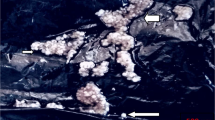Abstract
In this study, we investigate the toxic effects of cobalt chloride on some hematological factors of the carp Cyprinus carpio, such as white blood cell count, red blood cell count, hemoglobin, hematocrit, mean corpuscular volume, mean corpuscular hemoglobin, and mean corpuscular hemoglobin concentration. At first, LC50 of cobalt in C. carpio was measured during 96 h after exposure. Also, physicochemical parameters of water including pH, dissolved oxygen, viscosity, temperature, and conductivity were monitored, continuously. The results showed that LC50 values of cobalt in C. carpio were 327 and 328 mg/L in two replicates, respectively. Then, the changes in some hematological factors in the five treatment groups placed under concentration of 100, 200, 300, 400, and 500 mg/L cobalt were compared with the control group. Based on hematological tests conducted in this research, exposure of carp to 500- and 300-mg/L concentrations of cobalt in 48 h showed significant difference (p < 0.05) in white blood cell count. The concentration of 500 mg/L cobalt in 24 h showed a significant difference in the amount of hemoglobin, number of red blood cells, and hematocrit level as compared with the control group. The concentration of 100 mg/L cobalt in 48 h did not show a significant difference in comparison with the control group (p > 0.05). Also, the concentration of 500 mg/L cobalt in 24 h showed a significant difference in the amount of mean corpuscular volume and mean corpuscular hemoglobin as compared with the control group and other treatments. Also, the percentage of mean corpuscular hemoglobin concentration in a concentration of 200 mg/L cobalt in 24 h showed a significant difference as compared with the control group and other treatments.







Similar content being viewed by others
References
Abernathy AR, Larson GL, Mathews RC (1984) Heavy metals in the surficial sediments of Fontana Lake, North Carolina. Water Res 18:351–354
Diagomanolin V, Farhang M, Ghazi-Khansari M, Jafarzadeh N (2004) Heavy metals (Ni, Cr, Cu) in the Karoon waterway river, Iran. Toxicol Lett 151(1):63–67
Beijer K, Jernelöv A (1986) Sources, transport and transformation of metals in the environment. In: Friberg L, Nordberg GF, Vouk VB (eds) Handbook on the toxicology of metals. Elsevier, Amsterdam, pp 68–84
Förstner U, Wittmann GTW (1979) Metal pollution in the aquatic environment. Springer-Verlag, New York
Daka ER, Allen JR, Hawkins SJ (2003) Heavy metal contamination in sediment and biomonitors from sites in the Isle of Man. Mar Pollut Bull 46:784–794
Bryan GW, Langston WJ (1992) Bioavailability, accumulation and effects of heavy metals in sediments with special reference to United Kingdom estuaries: a review. Environ Pollut 76:89–131
Biney CA (1991) The distribution of terrace heavy metals in the kpong Headpond and lower Volta River Ghana. In: Shastree NKK (ed) Perspectives in aquatic entomology. Marendre publishing House, Delhi
Okoye BCO (1991) Heavy metals and organisms in the Logos Lagoon, surface waters. Int J Environ Stud 38:131–141
Gray MR (1995) Fundamentals of aquatic toxicology. Ecol. Services Inc., pp 85–97
Chan HM, Trifonopoulos M, Ing A, Receveur O, Johnson E (1999) Consumption of freshwater fish in Kahnawake: risks and benefits. Environ Res 80(2):213–222
WHO (1999) Food safety issues associated with products from aquaculture. Report of a Joint World Health Organization. Tech Rep 883(i–vii):1–55
Wong CK, Wong PP, Chu LM (2001) Heavy metals concentrations in marine fishes collected from fish culture sites in Hong Kong. J Arch Environ Contam Toxicol 40(1):60–69
Fazeli MS, Abtahi B, Sabbagh Kashani A (2006) The assay of Pb. Ni and Zn accumulation in the tissues of Liza aurata in the south Caspian sea. Iranian Fisheries Scientific J 1:66
Curtis MW, Ward CH (1981) Aquatic toxicity of forty industrial chemicals: testing in support of hazardous substance spill prevention regulation. Hydrology 51(1–4):359–367
Ghavam Mostafavi P (2001) Investigation of cadmium effects on HPI axis (hypothalamus–hypophysis–interrenal) in Cyprinus carpio. Msc. Thesis of marine biology, p 98
Aalami A (2003) The toxic effects of Cadmium on some hematological factors and hematopoietic tissues in rainbow trout (Oncorhynchus mykiss). Msc. thesis of marine biology, Islamic Azad, North branch of Tehran, p 139
Author information
Authors and Affiliations
Corresponding author
Rights and permissions
About this article
Cite this article
Saeedi Saravi, S.S., Karami, S., Karami, B. et al. Toxic Effects of Cobalt Chloride on Hematological Factors of Common Carp (Cyprinus carpio). Biol Trace Elem Res 132, 144–152 (2009). https://doi.org/10.1007/s12011-009-8388-8
Received:
Accepted:
Published:
Issue Date:
DOI: https://doi.org/10.1007/s12011-009-8388-8




